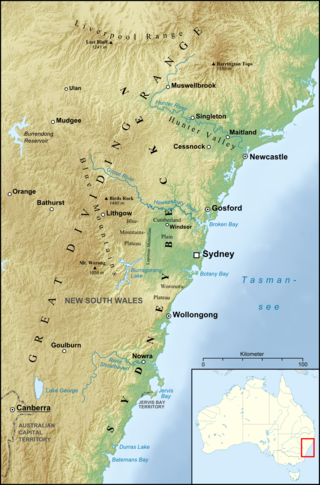
The Sydney Basin is an interim Australian bioregion and is both a structural entity and a depositional area, now preserved on the east coast of New South Wales, Australia and with some of its eastern side now subsided beneath the Tasman Sea. The basin is named for the city of Sydney, on which it is centred.

Barrenjoey is a locality in the suburb of Palm Beach, at the most northern tip of Pittwater. The headland is made up primarily of sandstones of the Newport Formation, the top third is a cap of Hawkesbury sandstone. Around 10,000 years ago the headland was cut off from the mainland due to the rising sea level; subsequent buildup of a sand spit or tombolo reconnected the island to the mainland. It is the location of the Barrenjoey Head Lighthouse, a lighthouse that was first lit in 1881. In 1995 Barrenjoey was gazetted into Ku-ring-gai Chase National Park.

The Wianamatta Group is a geological feature of the Sydney Basin, New South Wales, Australia that directly overlies the older Hawkesbury sandstone and generally comprise fine grained sedimentary rocks such as shales and laminites as well as less common sandstone units.

The Narrabeen group of sedimentary rocks occurs in the Sydney Basin in eastern Australia. This series of rocks was formed in the Triassic Period.
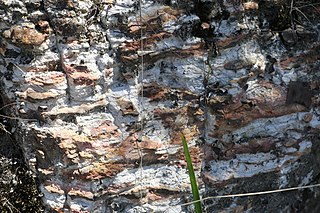
The Mittagong Formation is a sedimentary rock unit in the Sydney Basin in eastern Australia.
Geologically the Australian state of New South Wales consists of seven main regions: Lachlan Fold Belt, the Hunter-Bowen Orogeny or New England Orogen (NEO), the Delamerian Orogeny, the Clarence Moreton Basin, the Great Artesian Basin, the Sydney Basin, and the Murray Basin.

The geology of Queensland can be subdivided into several regions with different histories. Along the east coast is a complex of Palaezoic to Cainozoic rocks while much of the rest of the state is covered by Cretaceous and Cainozoic rocks. A Precambrian basement is found in the north west and Cape York regions. The Thomson Orogen occurs in the central and southern parts of Queensland, but is mostly covered by younger basins.
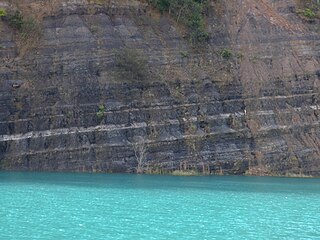
The Clarence Moreton Basin is a Mesozoic sedimentary basin on the easternmost part of the Australian continent. It is located in the far north east of the state of New South Wales around Lismore and Grafton and in the south east corner of Queensland. It is the part of the Great Artesian Basin that extends to the east coast in Australia's central eastern lowlands.

Bringelly Shale is a component of the Wianamatta group of sedimentary rocks in the Sydney Basin of eastern Australia. Formed in the Triassic Period, it has an extensive outcrop in the western parts of Sydney. The shale has its greatest geographical extent at Bringelly, near the suburb of Liverpool.

Minchinbury Sandstone is a component of the Wianammatta Group of sedimentary rocks in the Sydney Basin of eastern Australia.

Bald Hill Claystone is a sedimentary rock found in the Sydney Basin in eastern Australia. It is part of the Clifton sub-group of the Narrabeen Group of sedimentary rocks. It was formed by weathering of the Gerringong Volcanics in the early Triassic. Named after Bald Hill, in the northern Illawarra, where it is 15 metres thick. The claystone is easily noticed at Long Reef, where it is 18 metres thick.

St Michaels Cave is situated in the Sydney suburb of Avalon Beach. This sea-side cave is around 110 metres long, 15 metres high and 10 metres wide. The original colonial owner was a Reverend John Therry, who planned to deliver lectures within the cave and build a church above it. The cave was formed by the erosion of a jurassic dyke through triassic sedimentary rocks. The cave is known to be a breeding site for Common bent-wing bats and Large-eared pied bats.

The Garie Formation is a narrow band of sedimentary rocks occurring in the Sydney Basin in eastern Australia. This stratum is up to 8 metres thick, situated below the sandstones of the Newport Formation. Formed in the mid-Triassic, it is part of the Narrabeen Group of sedimentary rocks. Garie formation consists of layers of clay pellet sandstone, dark lithic particles, spotted volcanic deposits and chocolate coloured claystone bands.

Bulgo Sandstone is a sedimentary rock occurring in the Sydney Basin in eastern Australia. This stratum is up to 100 metres thick, formed in the early Triassic (Olenekian). A component of the Narrabeen Group of sedimentary rocks. It consists of layers of fine to medium-grained quartz-lithic sandstone, with lenticular shale interbeds.
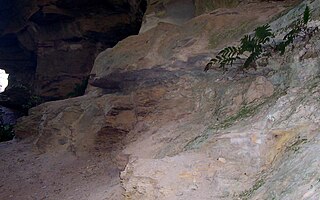
Mount York Claystone is a narrow band of sedimentary rocks occurring in the Sydney Basin in eastern Australia. This stratum is up to 13 metres thick. Mount York Claystone consists of red brown claystones, of fine‐grained and coarsely oolitic, kaolinite clayrocks.
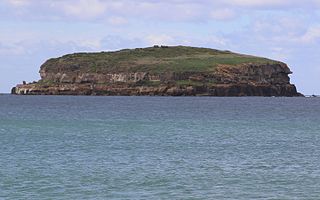
Munmorah Conglomerate is a geologic formation in the Sydney Basin in eastern Australia. This stratum is up to 140 metres thick. Formed in the early-Triassic, it is part of the Narrabeen Group of sedimentary rocks. This formation includes medium to coarse-grained sandstone and conglomerate. With minor amounts of siltstone and claystone. Below the Munmorah Conglomerates are Newcastle Coal Measures, originating from the Permian.

The Terrigal Formation is a geologic formation in the Sydney Basin in eastern Australia. Commonly seen in the Central Coast region, this stratum is up to 330 metres thick. Formed in the early to mid Triassic, it is part of the Narrabeen Group of sedimentary rocks. This formation includes interbedded fine to medium-grained sandstone and siltstone, with minor deposits of claystone. Hawkesbury Sandstone occasionally overlies the Terrigal Formation. Numerous fossils are known from this area, including the temnospondyl amphibian Arenaerpeton supinatus.
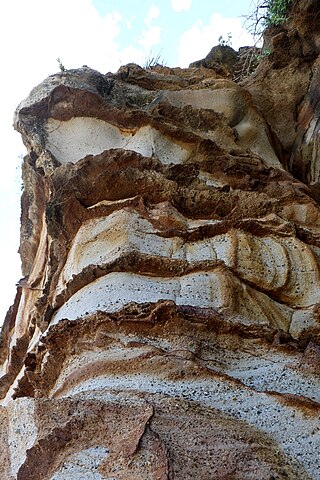
Scarborough Sandstone is a geologic formation in the Sydney Basin in eastern Australia. Commonly seen in the Illawarra region, this stratum is up to 26 metres thick. Formed in the early Triassic, it is part of the Narrabeen Group of sedimentary rocks. This formation includes quartz-lithic sandstone, sometimes with pebbles.

Stanwell Park Claystone is a geologic formation in the Sydney Basin in eastern Australia. Commonly seen in the Illawarra region, this stratum is up to 79 metres thick. Formed in the early Triassic, it is part of the Narrabeen Group of sedimentary rocks.This formation includes red, green and grey shale with quartz-lithic sandstone.
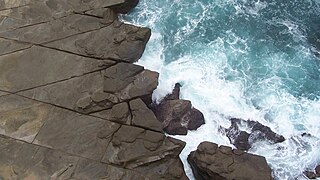
Wombarra Claystone is a geologic formation in the Sydney Basin in eastern Australia. Commonly seen in the Illawarra region, this stratum is up to 30 metres thick. Formed in the late Permian to the early Triassic, it is part of the Narrabeen Group of sedimentary rocks. This formation includes grey shale, and minor quartz-lithic sandstone.


















